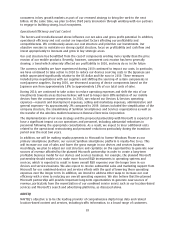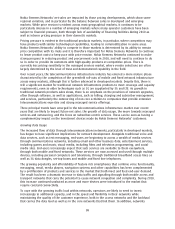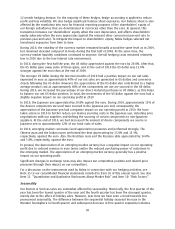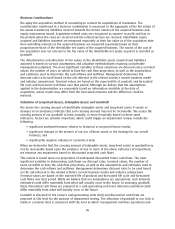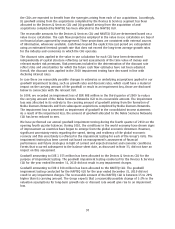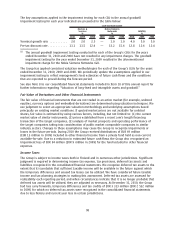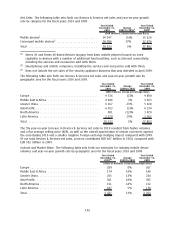Nokia 2010 Annual Report Download - page 94
Download and view the complete annual report
Please find page 94 of the 2010 Nokia annual report below. You can navigate through the pages in the report by either clicking on the pages listed below, or by using the keyword search tool below to find specific information within the annual report.adjustment. Devices & Services and certain Nokia Siemens Networks service revenue is generally
recognized on a straight line basis over the service period unless there is evidence that some other
method better represents the stage of completion. Devices & Services and NAVTEQ license fees from
usage are recognized in the period when they are reliably measurable which is normally when the
customer reports them to the Group.
Devices & Services, NAVTEQ and Nokia Siemens Networks may enter into multiple component
transactions consisting of any combination of hardware, services and software. The commercial effect
of each separately identifiable element of the transaction is evaluated in order to reflect the
substance of the transaction. The consideration from these transactions is allocated to each separately
identifiable component based on the relative fair value of each component. The consideration
allocated to each component is recognized as revenue when the revenue recognition criteria for that
element have been met. The Group determines the fair value of each component by taking into
consideration factors such as the price when the component is sold separately by the Group, the price
when a similar component is sold separately by the Group or a third party and cost plus a reasonable
margin.
Nokia Siemens Networks revenue and cost of sales from contracts involving solutions achieved
through modification of complex telecommunications equipment is recognized on the percentage of
completion basis when the outcome of the contract can be estimated reliably. This occurs when total
contract revenue and the cost to complete the contract can be estimated reliably, it is probable that
economic benefits associated with the contract will flow to the Group, and the stage of contract
completion can be measured. When we are not able to meet those conditions, the policy is to
recognize revenues only equal to costs incurred to date, to the extent that such costs are expected to
be recovered. Completion is measured by reference to costs incurred to date as a percentage of
estimated total project costs using the costtocost method.
The percentage of completion method relies on estimates of total expected contract revenue and
costs, as well as the dependable measurement of the progress made towards completing the
particular project. Recognized revenues and profit are subject to revisions during the project in the
event that the assumptions regarding the overall project outcome are revised. The cumulative impact
of a revision in estimates is recorded in the period such revisions become likely and estimable. Losses
on projects in progress are recognized in the period they become likely and estimable.
Nokia Siemens Networks’ current sales and profit estimates for projects may change due to the early
stage of a longterm project, new technology, changes in the project scope, changes in costs, changes
in timing, changes in customers’ plans, realization of penalties, and other corresponding factors.
Customer Financing
We have provided a limited number of customer financing arrangements and agreed extended
payment terms with selected customers. In establishing credit arrangements, management must
assess the creditworthiness of the customer and the timing of cash flows expected to be received
under the arrangement. However, should the actual financial position of our customers or general
economic conditions differ from our assumptions, we may be required to reassess the ultimate
collectability of such financings and trade credits, which could result in a writeoff of these balances
in future periods and thus negatively impact our profits in future periods. Our assessment of the net
recoverable value considers the collateral and security arrangements of the receivable as well as the
likelihood and timing of estimated collections. The Group endeavors to mitigate this risk through the
transfer of its rights to the cash collected from these arrangements to thirdparty financial institutions
on a nonrecourse basis in exchange for an upfront cash payment. During the past three fiscal years
the Group has not had any writeoffs or impairments regarding customer financing. The financial
impact of the customer financing related assumptions mainly affects the Nokia Siemens Networks
segment. See also Note 35(b) to our consolidated financial statements included in Item 18 of this
annual report for a further discussion of longterm loans to customers and other parties.
93


